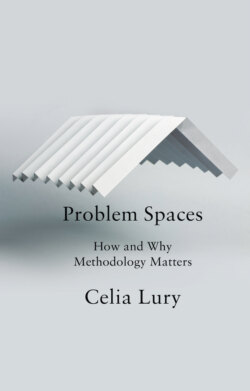Problem Spaces

Реклама. ООО «ЛитРес», ИНН: 7719571260.
Оглавление
Celia Lury. Problem Spaces
Contents
Guide
Pages
Problem Spaces. How and Why Methodology Matters
Copyright page
Acknowledgements
Introduction: The Compulsion of Composition
So, what is a problem space?
Compositional methodology
Becoming topological
The structure of the book
Some general comments
Notes
– 1 – What is a Problem Space?
Approach 1: Dewey
Approach 2: Simon
The times of problem spaces
Thinking context
Approach 3: Haraway
Approach 4: Jullien
The methodological potential of the situation
Approach 5: Appadurai
Across
Notes
– 2 – The Parasite and the Octopus
1. Explicitation and literalization
2. Representation, semiotics and cognition
3. Observing the observed
4. The geo-politics of methodology
5. (Non-)Representation and/or participation
Conclusion
Notes
– 3 – Indexing the Human (with Ana Gross)1
Indicators of price
Platformization
Notes
– 4 – Platforms and the Epistemic Infrastructure
Platformization
1. The architectural
2. The political
3. The computational
4. The figurative
Conclusion
Notes
– 5 – More than Circular
From model systems to platforms: the case of classification
Double trouble
1. The natively artificial character of the empirical
2. The ontological multiplicity of the epistemological object
Transcontextualism
Conclusion
Notes
– 6 – Know-ability and Answer-ability
The internalization of science?
Interface effects
Know-ability
Interface control
Answer-ability
Conclusion
Notes
Conclusion: How and Why Methodology Matters
Notes
References
Artwork
Index
POLITY END USER LICENSE AGREEMENT
Отрывок из книги
Celia Lury
Research for this monograph was supported by an ESRC Professorial Fellowship: Order and Continuity: Methods for Change in a Topological Society, Ref No: 978-1444339598. I am grateful for this support.
.....
For both Dewey and Simon, then, the relation of a problem to a context or environment not only changes in time but is cognitively distributed; for both, a notion of problematization that insists upon a stable, once-and-for-all distinction between a problem and a single environment is inadequate. This insight is acknowledged in Dewey’s use of the concept ‘pattern of inquiry’, since patterning typically involves a parallax effect of figure-ground, allowing the two-way relation between figure and ground, an object (or problem) and its environment(s), to be surfaced as part of an inquiry. Relatedly, the emphasis on the iterative relation between representation and intervention that follows from Simon’s use of the term of design leads him to emphasize the importance of the interactivity of interfaces to the artificial sciences. Indeed, for Simon, the interface is the primary epistemic tool of the artificial sciences:
An artifact can be thought of as a meeting point – an “interface” in today’s terms – between an “inner” environment, the substance and organization of the artifact itself, and an “outer” environment, the surroundings in which it operates. If the inner environment is appropriate to the outer environment, or vice versa, the artifact will serve its intended purpose. (1996: 6)
.....